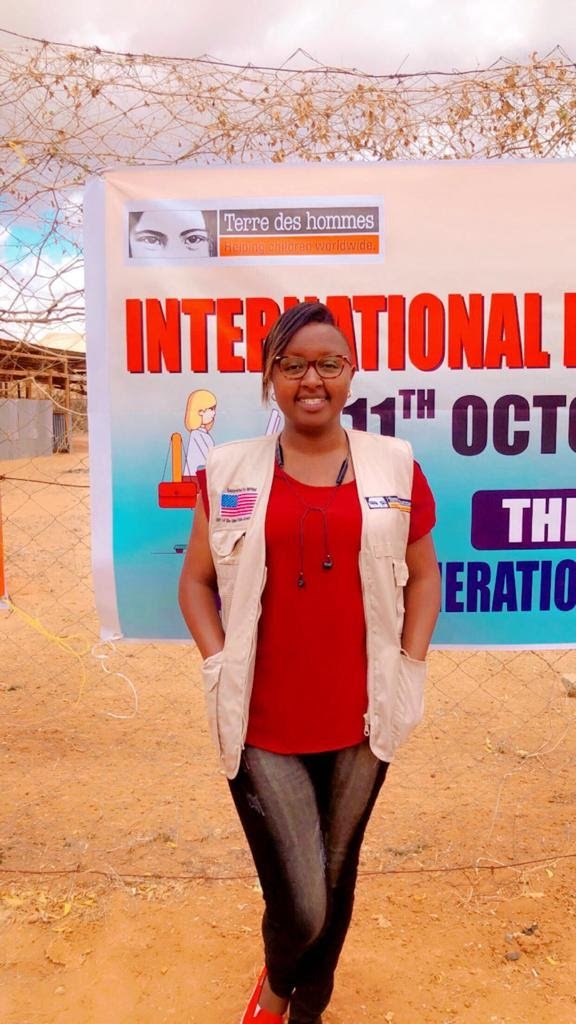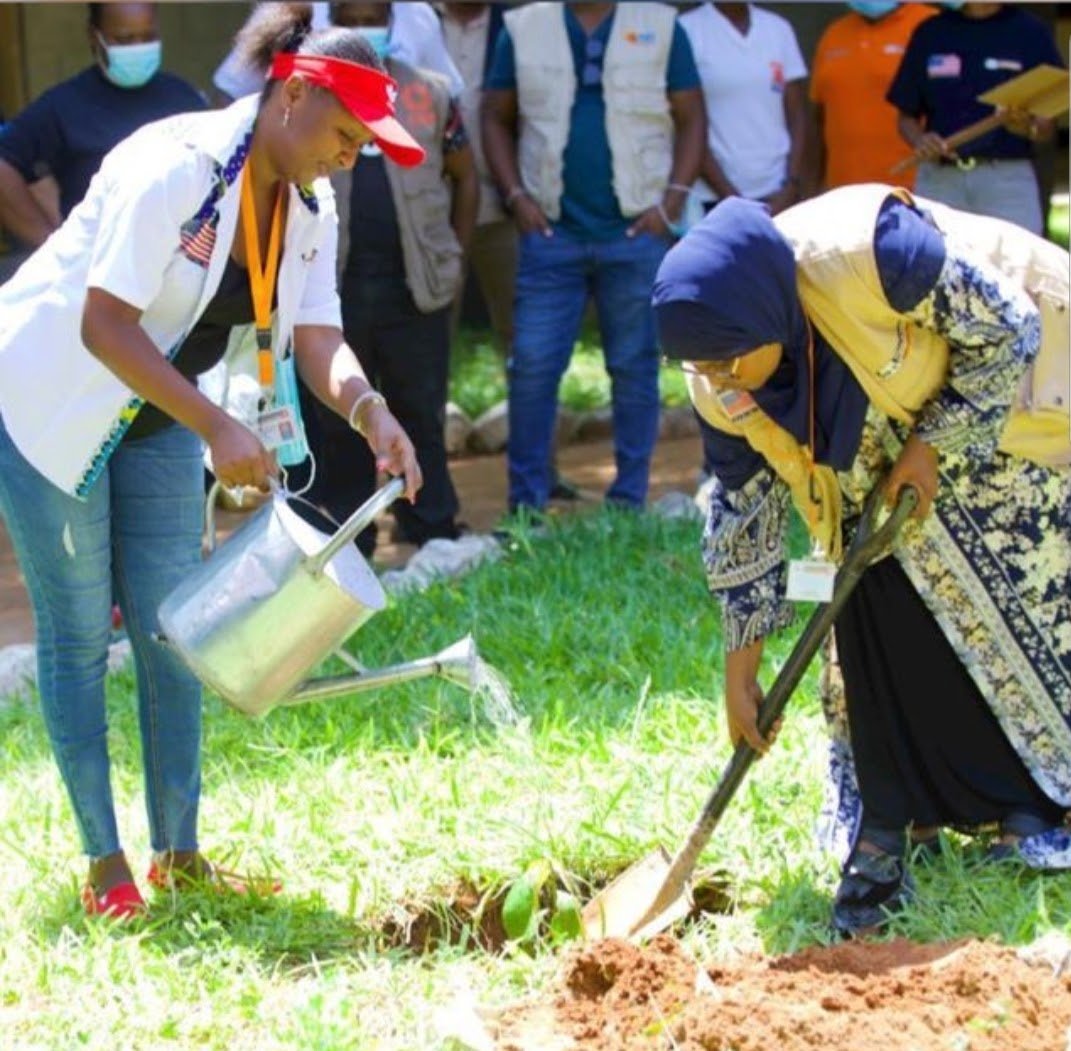One GBV case is one too many: Women and Girls Should feel Safe and Protected
Judy Ngina at Dadaab Refugee Complex (Image credit:Judy Ngina)
Author: Naliaka Odera
Gender Based Violence (GBV)is a harmful act that can hinder girls and women from self actualizing. It destroys their aspirations, their economic performance, violates their personal freedoms and undermines their sense of self-worth and self-esteem. It is anobstacle to development in the world of work. The UN has committed to “achieve gender equality and empower all women and girls”, under SDG5, by eliminating all forms of violence against all women and girls, by 2030. While all women are potentially at risk,female refugees and asylum seekers are highly vulnerable to all forms of gender based violence.
About 480 km from Kenya’s capital city, Nairobi, is the Dadaab Refugee Complex. A young researcher, Mawazo Alumna Judy Ngina, is giving hope to victims and survivors of GBV. Dadaab is split into 3 camps, Dagahaley, Hagadera, and Ifo, and has a population of over 200,000 refugees and asylum seekers from South Sudan, Eritrea, Ethiopia, Burundi,and Uganda, making it the third largest refugee complex in the world. Anecdotal reports of violence against women and girls are common in the refugee camp.
Judy Ngina working as a Refugee Protection Officer at Dadaab Complex attending anevent (Image credit: Judy Ngina)
As a researcher, Judy has expressed no small amount of frustration at the lack of data and quantitative studies on the issue of GBV. The last known study occurred in June 2015 where 533 Sexual Gender Based Violence cases were reported in the camp, compared to 623 reported at the same time in 2014. More recent statistics are difficult to find (which in itself is a worrying fact), but based on trends, it is safe to say that these numbers have probably more than doubled since. For instance, in 2021,REACH Initiative conducted a multi-sector needs assessment in Dadaab, and found that 84% of households reported women and girls feeling unsafe when they go to collect firewood, the main source of fuel used in the camps. Furthermore, 22% of households claimed that the girls had undergone Female Genital Mutilation, and 16% were in forced marriages.
Owing to the high rates of GBV in the complex, there have been deliberate efforts by organisations, communities, justice actors and individuals to address this issue. Judy is passionate about creating long term, sustainable solutions for refugee resettlement. She has spent four years supporting GBV survivors in Dadaab, three of which she worked as a child protection officer. “I have witnessed first hand how the systems in place can crack under immense pressure, thereby failing victims of Gender Based Violence,” she states
Judy Ngina at Dadaab Refugee Complex (Image credit: Judy Ngina)
Judy explains that at Dadaab, whenever there is a case of GBV, a victim first seeks medical attention at hospital facilities run by medical partners in the healthcare sector including Doctors without Borders (MSF), the International Rescue Committee (IRC), and the Kenya Red Cross Society (KRCS). Considering these cases are criminal in nature, at these sites, the medical partners will then make referrals to UNHCR and other relevant protection partners, as well as the police. “Sadly, at Dadaab, there is only one SubCounty Children’s Officer who intervenes in all matters involving minors. There is also one magistrate court that presides over cases from all the three camps in Dadaab,” she says,adding that understaffing within the criminal justice system further exacerbates the process of seeking justice for GBV survivors.
Judy points out that during the COVID-19 pandemic lock-down, the situation went from bad to worse. Many organisations that were offering temporary, physical employment to refugees at Dadaab went digital, causing many refugees to lose their sources of livelihood. The outcome was mass layoffs, rise in cases of insecurity, and violent crime.Additionally, a large-scale exercise to transfer refugees from Dadaab to Kakuma Refugees Camp was halted, with many refugees getting trapped in cramped transit camps. Staff were overwhelmed by the overcrowding, and maintaining security became tougher in those spaces. “So many GBV cases were reported during that time,” Judy shares.
Beyond the bureaucratic overwhelm that these understaffed positions encounter, Judy outlines two major factors that affect a GBV claim.First is a lack of sensitivity training on GBV-related issues for the officials handling the cases.Judy wonders if police officers manning gender desks in police stations are trained to handle victims and survivors of GBV in a professional and dignified manner. In her experience, police officers mix tradition and culture to normalise cases of GBV. Statistics show that GBV cases in families are most often inflicted by a relative or friend of the family, and lack of professionalism by officers can easily scare off someone from pursuing justice,leaving them suffering in silence.
Second is cases of GBV perpetrators fleeing the camp and vanishing via porous borders.Kenyan law dictates that a person can only be charged with a crime if they are in attendance of the court proceedings, meaning that in cases where the perpetrator has fled, cases cannot proceed. “Many of the victims are left with permanent emotional and sometimes physical scars. They may never experience closure,” she laments
Judy Ngina helps to plant a tree at Dadaab Refugee Complex (Image Credit: Judy Ngina)
But even in this darkness, there is hope. Judy points to one shining example of the importance of safety and support. Safe Haven, Judy explains, is a safe space at Dadaab Camp where only women and children are allowed.“While not a perfect system, it is so powerful to see a space where women and girls who have experienced GBV can live safely,” she explains. One key challenge with Safe Haven, is that it does not admit men who may also have suffered from abuse. Additionally, very little is known about the effects of this legislation on people belonging to the LGBTQIA+ community. While aware of this, and other challenges, and knowing there is still much to be done to address GBV in Dadaab and refugee camps like it, she is taking it one step at a time; one survivor at a time. The goal is to ensure that each girl and woman feels safe. In her words, “one case is too many”. “It starts with proper planning, to ensure that crowding in the transit spaces is never an issue again. There also needs to be economic and food cushioning, with allocated emergency funds and food in case of a crisis.” Addressing the prevailing resource deficit would further decrease criminal activity that people engage in when desperate.
From November 25th to December 10th, the Mawazo Institute participated in the global#OrangeTheWorldcampaign to end violence against Women. We believe that it is only in including expertise by researchers like Judy in the conversation, that we can truly see an end to GBV.
Further Reading:
Institute of Economic Affairs. (September 2009). “Status of Gender Desks at Police Stations in Kenya”. Report. https://ieakenya.or.ke/download/status-of-gender-desks-at-police-stations-in-kenya/
IRC (February 2018). “Violence, uncertainty, and resilience among refugee women and community workers: An evaluation of gender-based violence case management services in the Dadaab refugee camps”. Report. https://www.rescue.org/uk/report/violence-uncertainty-and-resilience-among-refugee-women-and-community-workers-evaluation
REACH (January 2022). “Research Terms of Reference Actor, service and infrastructure mapping in Dadaab refugee camps”. KEN2202, V1 Report. https://reliefweb.int/report/kenya/research-terms-reference-actor-service-and-infrastructure-mapping-dadaab-refugee-camps-ken2202-kenya-january-2021-v1#:~:text=It%20consists%20of%20three%20camps,from%20Somalia%20reside%20in%20Dadaab
UNHCR (2022). Gender Based Violence. Website. https://www.unhcr.org/gender-based-violence.html




